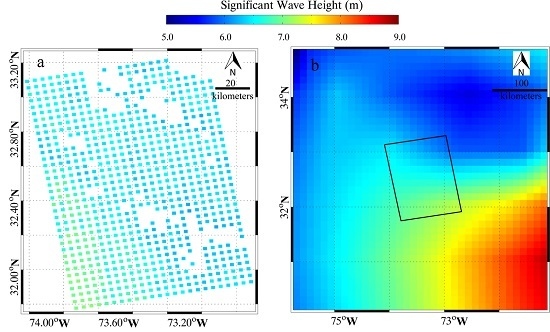An Empirical Algorithm for Wave Retrieval from Co-Polarization X-Band SAR Imagery
Abstract
:1. Introduction
2. Data Description
3. Development of Empirical Algorithm for Wave Retrieval at X-Band
3.1. Existing X-Band SAR Wind and Wave Algorithms
3.2. Empirical Algorithm for Wave Retrieval in Both VV- and HH-Polarization
4. Validation
4.1. Validation Against Buoys
4.2. Application in Trpocial Cyclone
5. Conclusions
Acknowledgments
Author Contributions
Conflicts of Interest
Appendix A
| Buoy ID | TS-X/TD-X Acquisition Time (YYYY-MM-DD) | Imaging Mode | Buoy ID | TS-X/TD-X Acquisition Time (YYYY-MM-DD) | Imaging Mode |
|---|---|---|---|---|---|
| 46013 | 2008-02-22 02:08 | StripMap | 46011 | 2011-03-13 14:07 | ScanSAR |
| 46026 | 2008-03-02 14:15 | StripMap | 46054 | 2011-03-15 01:59 | StripMap |
| 46029 | 2009-03-19 02:02 | ScanSAR | 46050 | 2011-10-23 14:30 | StripMap |
| 41048 | 2009-05-13 22:31 | StripMap | 41047 | 2011-10-25 10:51 | StripMap |
| 46025 | 2009-06-10 01:50 | ScanSAR | 46050 | 2011-10-26 02:11 | StripMap |
| 46221 | 2009-07-19 01:42 | ScanSAR | 46229 | 2011-10-26 02:10 | StripMap |
| 46221 | 2009-09-12 01:42 | ScanSAR | 46015 | 2011-11-06 02:10 | StripMap |
| 46028 | 2010-04-08 01:59 | ScanSAR | 41047 | 2011-11-06 22:39 | StripMap |
| 46015 | 2010-06-13 02:01 | ScanSAR | 46015 | 2011-11-28 02:10 | StripMap |
| 46013 | 2010-07-05 02:00 | ScanSAR | 46050 | 2011-12-04 02:02 | StripMap |
| 46029 | 2010-07-05 02:02 | StripMap | 46015 | 2011-12-04 02:01 | StripMap |
| 42036 | 2010-07-06 11:42 | StripMap | 41043 | 2012-01-23 22:20 | StripMap |
| 46028 | 2010-07-16 01:59 | StripMap | 46047 | 2012-02-01 13:59 | StripMap |
| 46011 | 2010-11-12 14:07 | StripMap | 51000 | 2012-02-26 16:19 | StripMap |
| 46022 | 2010-11-16 14:31 | StripMap | 46222 | 2012-03-27 13:59 | StripMap |
| 46011 | 2010-11-17 14:15 | StripMap | 46011 | 2012-05-23 01:51 | StripMap |
| 44008 | 2010-11-20 22:25 | StripMap | 46025 | 2013-02-03 14:07 | ScanSAR |
| 51000 | 2010-12-13 16:19 | ScanSAR | 41048 | 2013-02-05 22:32 | StripMap |
| 46053 | 2010-12-15 14:07 | ScanSAR | 41002 | 2013-04-04 11:07 | ScanSAR |
| 46012 | 2010-12-17 02:00 | ScanSAR | 46011 | 2013-06-28 01:59 | ScanSAR |
| 51000 | 2010-12-20 04:14 | ScanSAR | 46053 | 2013-09-22 14:07 | ScanSAR |
| 51000 | 2010-12-24 16:19 | ScanSAR | 52200 | 2015-04-13 08:22 | StripMap |
| 46050 | 2011-03-04 02:02 | ScanSAR |
References
- Ren, Y.Z.; He, M.X.; Lehner, S. An algorithm for the retrieval of sea surface wind fields using X-band TerraSAR-X data. Int. J. Remote Sens. 2012, 33, 7310–7336. [Google Scholar] [CrossRef]
- Shao, W.Z.; Li, X.M.; Lehner, S.; Guan, C.L. Development of polarization ratio model for sea surface wind field retrieval from TerraSAR-X HH polarization data. Int. J. Remote Sens. 2014, 35, 4046–4063. [Google Scholar] [CrossRef]
- Ren, Y.Z.; Li, X.M.; Zhou, G. Sea surface wind retrievals from SIR-C/X-SAR data: a revisit. Remote Sens. 2015, 7, 3548–3564. [Google Scholar] [CrossRef]
- Li, X.M.; Lehner, S. Algorithm for sea surface wind retrieval from TerraSAR-X and TanDEM-X Data. IEEE Trans. Geosci. Remote Sens. 2014, 52, 2928–2939. [Google Scholar] [CrossRef]
- Shao, W.Z.; Zhang, Z.; Li, X.M.; Wang, W.L. Sea surface wind speed retrieval from TerraSAR-X HH-polarization data using an improved polarization ratio model. IEEE J. Sel. Top. Appl. Earth Obs. Remote Sens. 2016, 9, 4991–4997. [Google Scholar] [CrossRef]
- Bruck, M.; Lehner, S. Coastal wave field extraction using TerraSAR-X data. J. Appl. Remote Sens. 2013, 107, 333. [Google Scholar] [CrossRef]
- Bruck, M. Sea state measurements using the XWAVE algorithm. Int. J. Remote Sens. 2015, 36, 3890–3912. [Google Scholar] [CrossRef]
- Pleskachevsky, A.L.; Rosenthal, W.; Lehner, S. Meteo-Marine parameters for highly variable environment in coastal regions from satellite radar images. ISPRS J. Photogramm. 2016, 119, 464–484. [Google Scholar] [CrossRef]
- Shao, W.Z.; Li, X.F.; Sun, J. Ocean wave parameters retrieval from TerraSAR-X images validated against buoy measurements and model results. Remote Sens. 2015, 7, 12815–12828. [Google Scholar] [CrossRef]
- Sun, J.; Guan, C.L. Parameterized first-guess spectrum method for retrieving directional spectrum of swell-dominated waves and huge waves from SAR images. Chin. J. Oceanol. Limn. 2006, 24, 12–20. [Google Scholar]
- Sun, J.; Kawamura, H. Retrieval of surface wave parameters from SAR images and their validation in the coastal seas around Japan. J. Oceanogr. 2009, 65, 567–577. [Google Scholar] [CrossRef]
- Lin, B.; Shao, W.Z.; Li, X.F.; Li, H.; Du, X.Q.; Ji, Q.Y.; Cai, L.N. Development and validation of an ocean wave retrieval algorithm for VV-polarization Sentinel-1 SAR data. Acta Oceanol. Sin. 2017, 36, 95–101. [Google Scholar] [CrossRef]
- Alpers, W.; Ross, D.B.; Rufenach, C.L. On the detectability of ocean surface waves by real and synthetic radar. J. Geophys. Res. 1981, 86, 10529–10546. [Google Scholar] [CrossRef]
- Alpers, W.; Bruning, C. On the relative importance of motion-related contributions to SAR imaging mechanism of ocean surface waves. IEEE Trans. Geosci. Remote Sens. 1986, 24, 873–885. [Google Scholar] [CrossRef]
- Hasselmann, K.; Hasselmann, S. On the nonlinear mapping of an ocean wave spectrum into a synthetic aperture radar image spectrum. J. Geophys. Res. 1991, 96, 10713–10729. [Google Scholar] [CrossRef]
- Hasselmann, S.; Bruning, C.; Hasselmann, K. An improved algorithm for the retrieval of ocean wave spectra from synthetic aperture radar image spectra. J. Geophys. Res. 1996, 101, 6615–6629. [Google Scholar] [CrossRef]
- Collard, F.; Ardhuin, F.; Chapron, B. Extraction of coastal ocean wave fields from SAR images. IEEE J. Ocean. Eng. 2005, 30, 526–533. [Google Scholar] [CrossRef]
- Mastenbroek, C.; de Valk, C.F. A semi-parametric algorithm to retrieve ocean wave spectra from synthetic aperture radar. J. Geophys. Res. 2000, 105, 3497–3516. [Google Scholar] [CrossRef]
- Schulz-Stellenfleth, J.; Lehner, S.; Hoja, D. A parametric scheme for the retrieval of two-dimensional ocean wave spectra from synthetic aperture radar look cross spectra. J. Geophys. Res. 2005, 110, 297–314. [Google Scholar] [CrossRef]
- WAMDIG. The WAM model—A third generation ocean wave prediction model. J. Phys. Oceanogr. 1988, 18, 1775–1810. [Google Scholar]
- Hasselmann, K. Measurements of wind-wave growth and swell decay during the Joint North Sea Wave Project (JONSWAP). Erganzung zur Deut. Hydrogr. Z. 1973, 12, 1–95. [Google Scholar]
- Johnsen, H.; Engen, G.; Hogda, K.A.; Chapron, B.; Desnos, Y.L. Validation of ENVISAT-ASAR wave mode Level 1 and 2 products using ERS SAR data. IEEE Int. Geosci. Remote Sens. Sym. Pro. 2000, 4, 1498–1500. [Google Scholar]
- Lyzenga, D.R. Unconstrained inversion of wave height spectra from SAR images. IEEE Trans. Geosci. Remote Sens. 2002, 40, 261–270. [Google Scholar] [CrossRef]
- Schulz-Stellenfleth, J.; Konig, T.; Lehner, S. An empirical approach for the retrieval of integral ocean wave parameters from synthetic aperture radar data. J. Geophys. Res. 2007, 112, 1–14. [Google Scholar] [CrossRef]
- Li, X.M.; Lehner, S.; Bruns, T. Ocean wave integral parameter measurements using Envisat ASAR wave mode data. IEEE Trans. Geosci. Remote Sens. 2011, 49, 155–174. [Google Scholar] [CrossRef]
- Stopa, J.E.; Ardhuin, F.; Collard, F.; Chapron, B. Estimating wave orbital velocities through the azimuth cut-off from space borne satellites. J. Geophys. Res. 2016, 120, 7616–7634. [Google Scholar] [CrossRef]
- Shao, W.Z.; Zhang, Z.; Li, X.F.; Li, H. Ocean wave parameters retrieval from Sentinel-1 SAR imagery. Remote Sens. 2016, 8, 707–721. [Google Scholar] [CrossRef]
- Grieco, G.; Lin, W.; Migliaccio, M.; Nirchio, F.; Portabella, M. Dependency of the Sentinel-1 azimuth wavelength cut-off on significant wave height and wind speed. Int. J. Remote Sens. 2016, 37, 5086–5104. [Google Scholar] [CrossRef]
- Stopa, J.E.; Mouche, A. Significant wave heights from Sentinel-1 SAR: validation and applications. J. Geophys. Res. 2017. [Google Scholar] [CrossRef]
- Fernandez, D.E.; Carswell, J.R.; Frasier, S.; Chang, P.S.; Black, P.G.; Marks, F.D. Dual-polarized C- and Ku-band ocean backscatter response to hurricane-force winds. J. Geophys. Res. 2006, 111, 275–303. [Google Scholar] [CrossRef]
- Hwang, P.A.; Fois, F. Surface roughness and breaking wave properties retrieved from polarimetric microwave radar backscattering. J. Geophys. Res. 2015, 120, 3640–3657. [Google Scholar] [CrossRef]
- Romeiser, R.; Graber, H.C.; Caruso, M.J.; Jensen, R.E.; Walker, D.T.; Cox, A.T. A new approach to ocean wave parameter estimates from C-band ScanSAR images. IEEE Trans. Geosci. Remote Sens. 2015, 53, 1320–1345. [Google Scholar] [CrossRef]
- Hersbach, H.; Stoffelen, A.; Haan, S.D. An improved C-band scatterometer ocean geophysical model function: CMOD5. J. Geophys. Res. 2007, 112, C03006. [Google Scholar] [CrossRef]
- Quilfen, Y.; Bentamy, A.; Elfouhaily, T.; Katsaros, K.; Tournadre, J. Observation of tropical cyclones by high-resolution scatterometry. J. Geophys. Res. 1998, 103, 7767–7786. [Google Scholar] [CrossRef]
- Masuko, H.; Okamoto, K.; Shimada, M.; Niwa, S. Measurement of microwave backscattering signatures of the ocean surface using X band and Ka band airborne scatterometers. J. Geophys. Res. 1986, 91, 13065–13083. [Google Scholar] [CrossRef]
- Li, X.F. The first Sentinel-1 SAR image of a typhoon. Acta Oceanol. Sin. 2015, 34, 1–2. [Google Scholar] [CrossRef]
- Li, X.F.; Zhang, J.A.; Yang, X.F.; Pichel, W.G.; DeMaria, M.; Long, D.; Li, Z.W. Tropical cyclone morphology from spaceborne synthetic aperture radar. Bull. Am. Meteorol. Soc. 2013, 94, 215. [Google Scholar] [CrossRef]
- Friedman, K.; Li, X.F. Storm patterns over the ocean with wide swath SAR. Johns Hopkins APL Tech. Dig. 2000, 21, 80–85. [Google Scholar]
- Li, X.F.; Pichel, W.G.; He, M.X.; Wu, S.; Friedman, K.; Clemente-Colon, P.; Zhao, C. Observation of hurricane-generated ocean swell refraction at the gulf stream north wall with the RADARSAT-1 synthetic aperture radar. IEEE Trans. Geosci. Remote Sens. 2002, 40, 2131–2142. [Google Scholar]
- Hwang, P.; Li, X.F.; Zhang, B. Retrieving hurricane wind speed from dominant wave parameters. IEEE J. Sel. Top. Appl. Earth Obs. Remote Sens. 2017, 1–10. [Google Scholar] [CrossRef]
- Zhang, B.; Perrie, W.G. Cross-polarized synthetic aperture radar: A new potential technique for hurricanes. Bull. Am. Meteorol. Soc. 2012, 93, 531–541. [Google Scholar] [CrossRef]

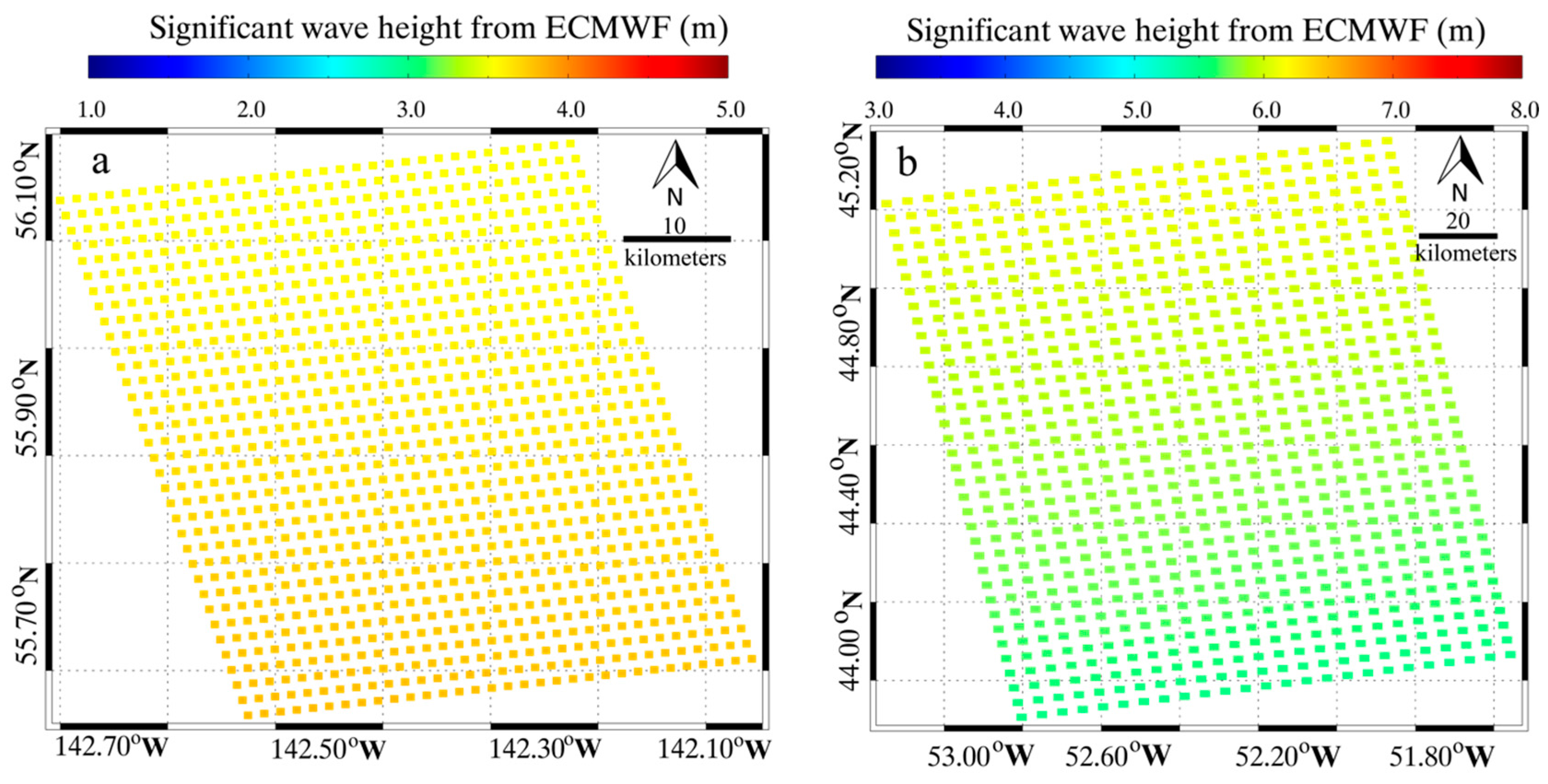

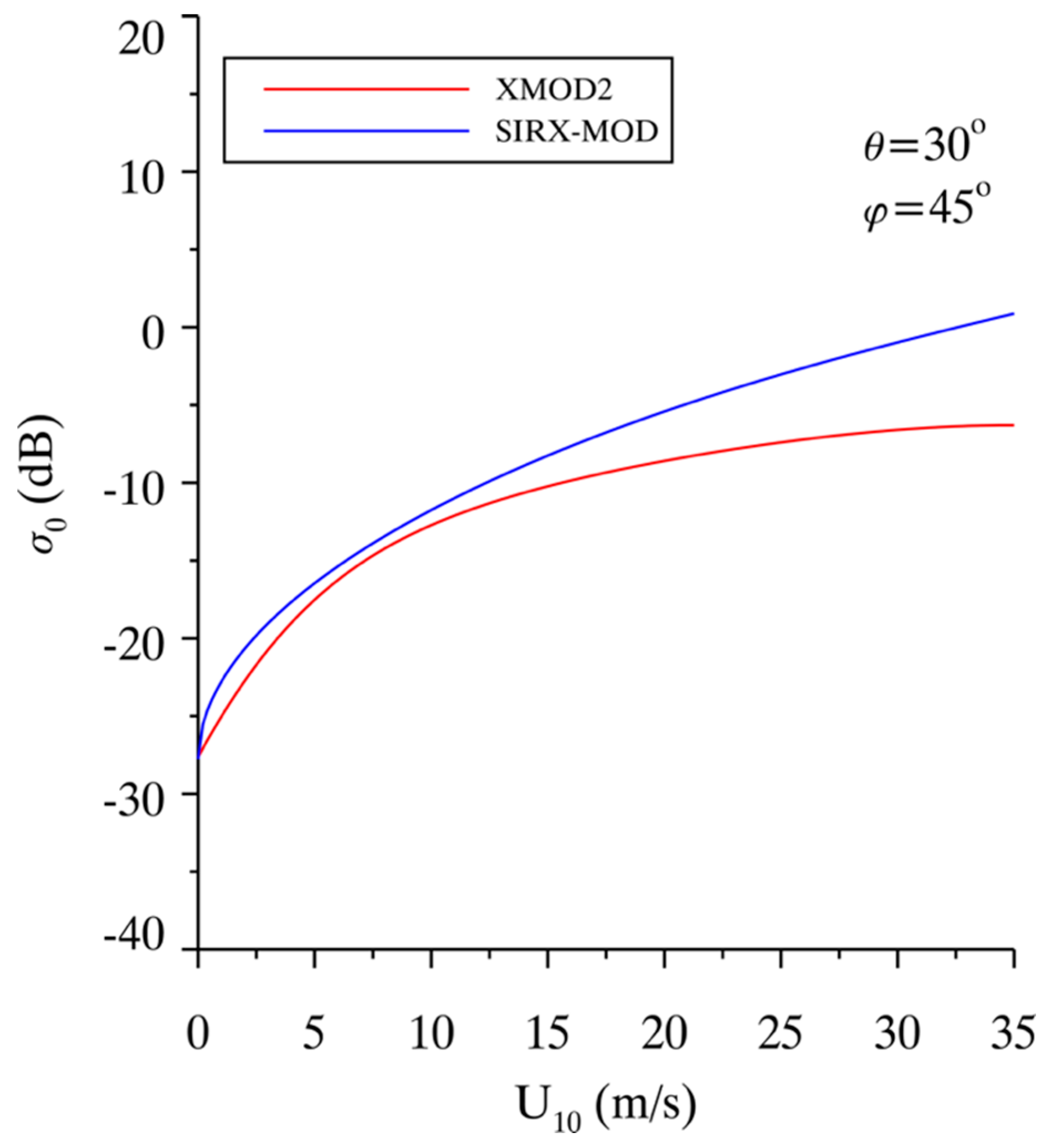
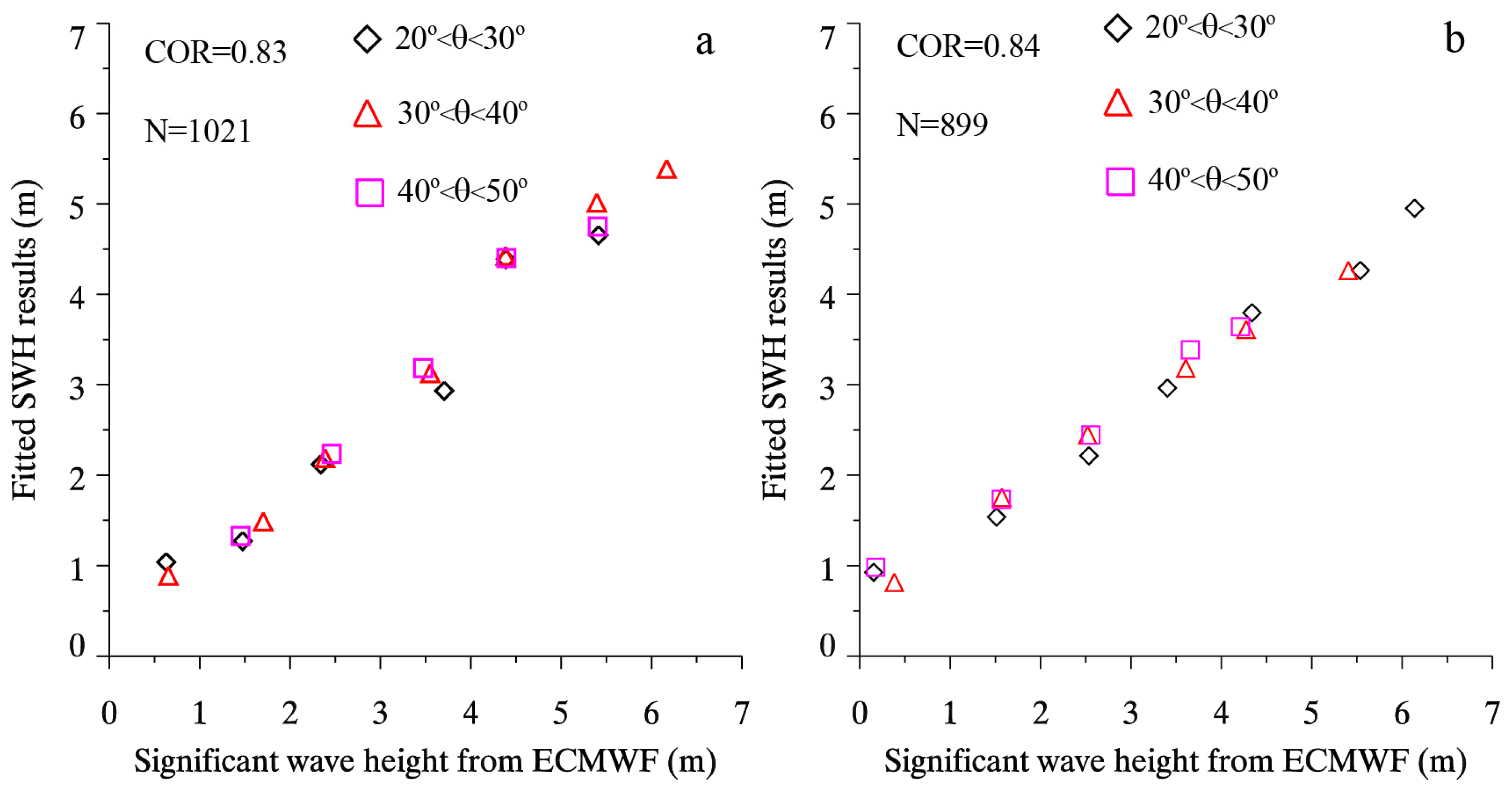
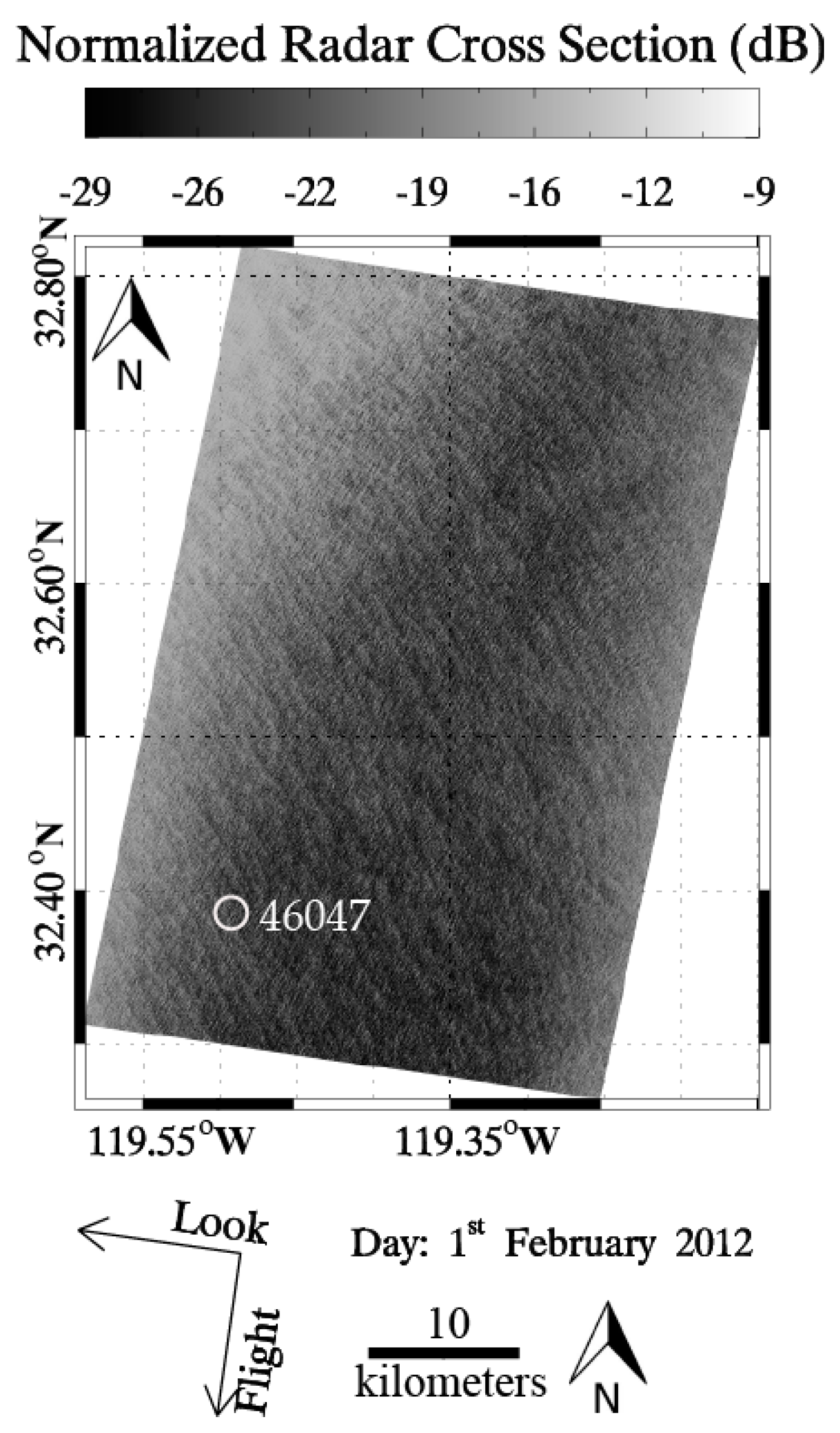
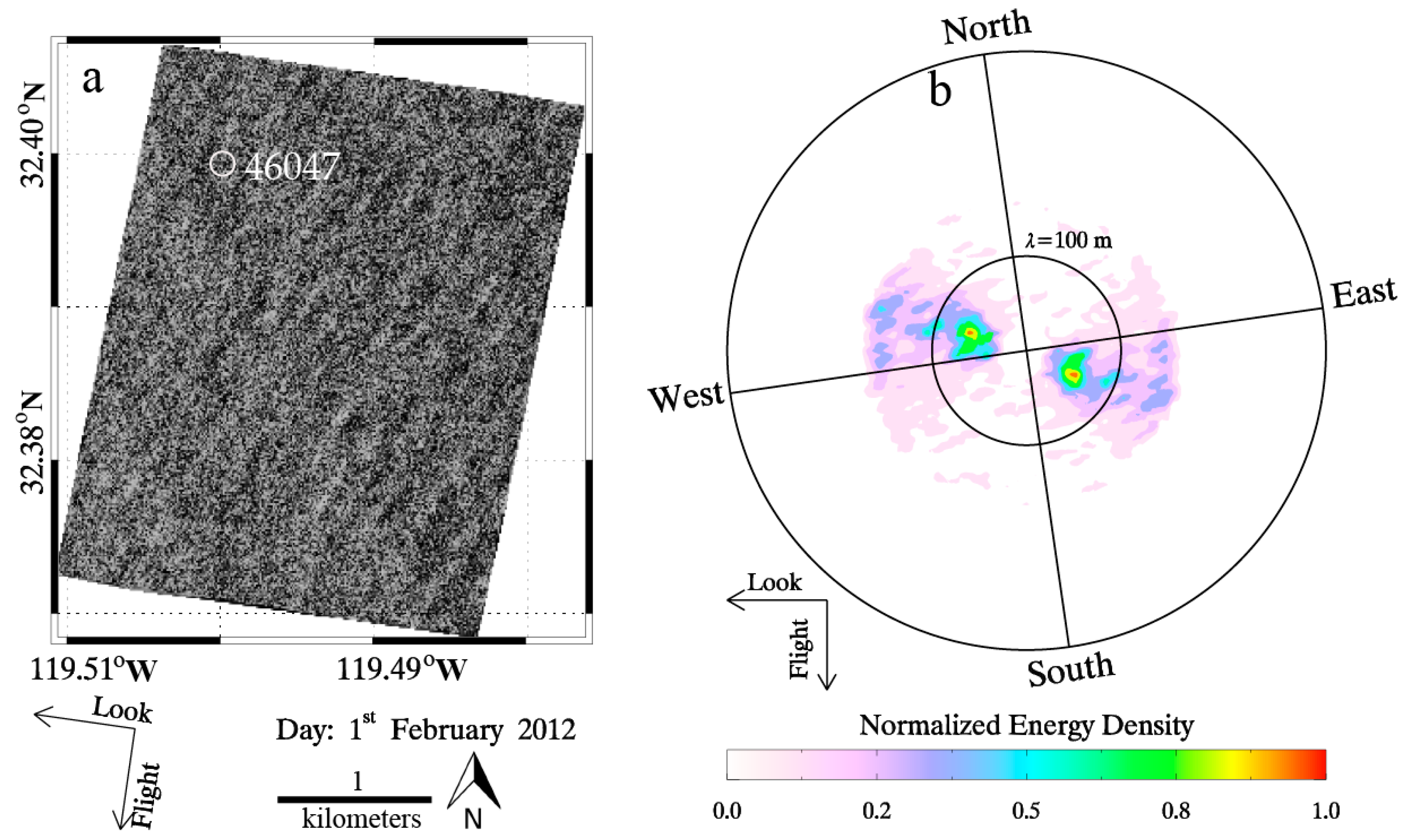
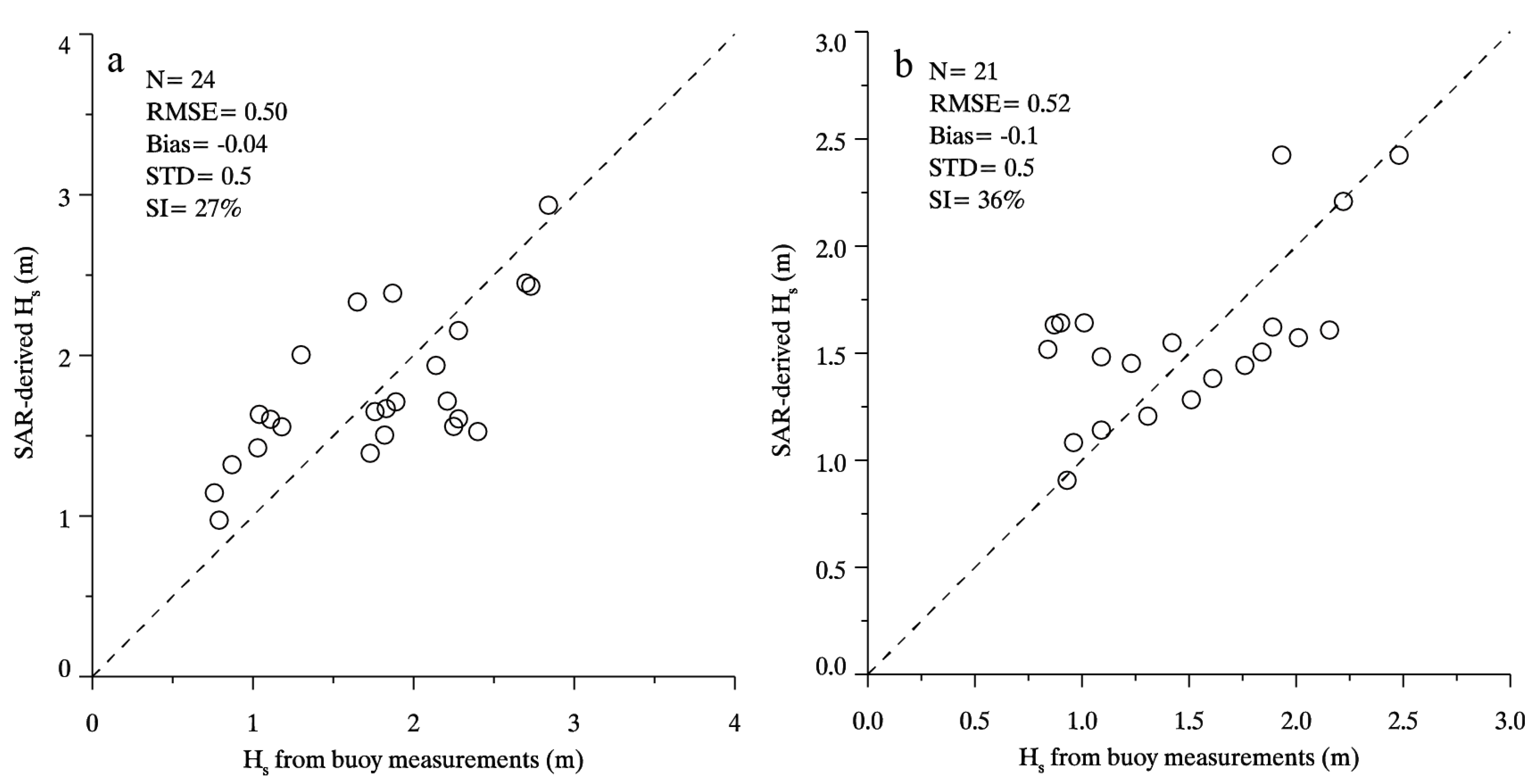
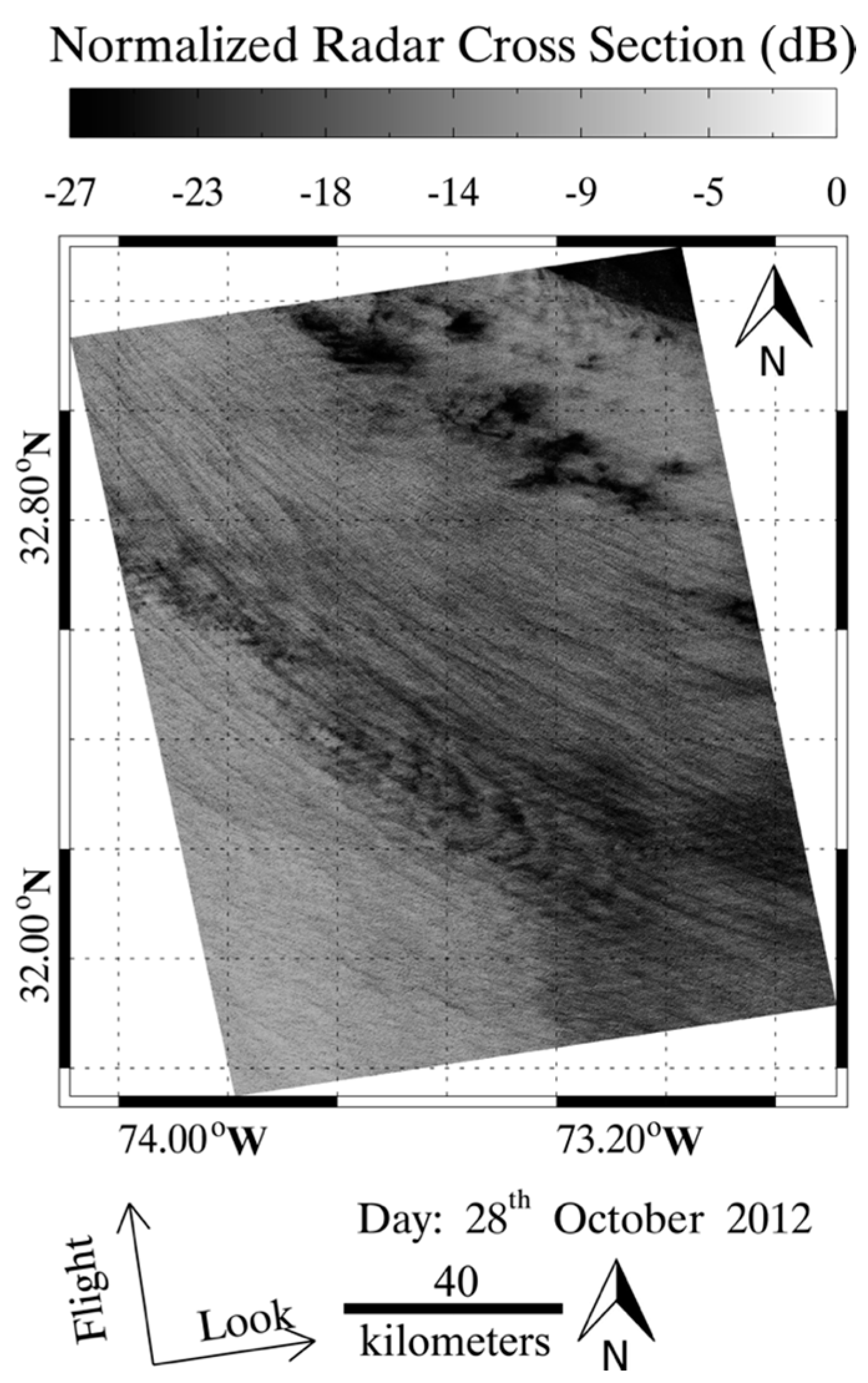

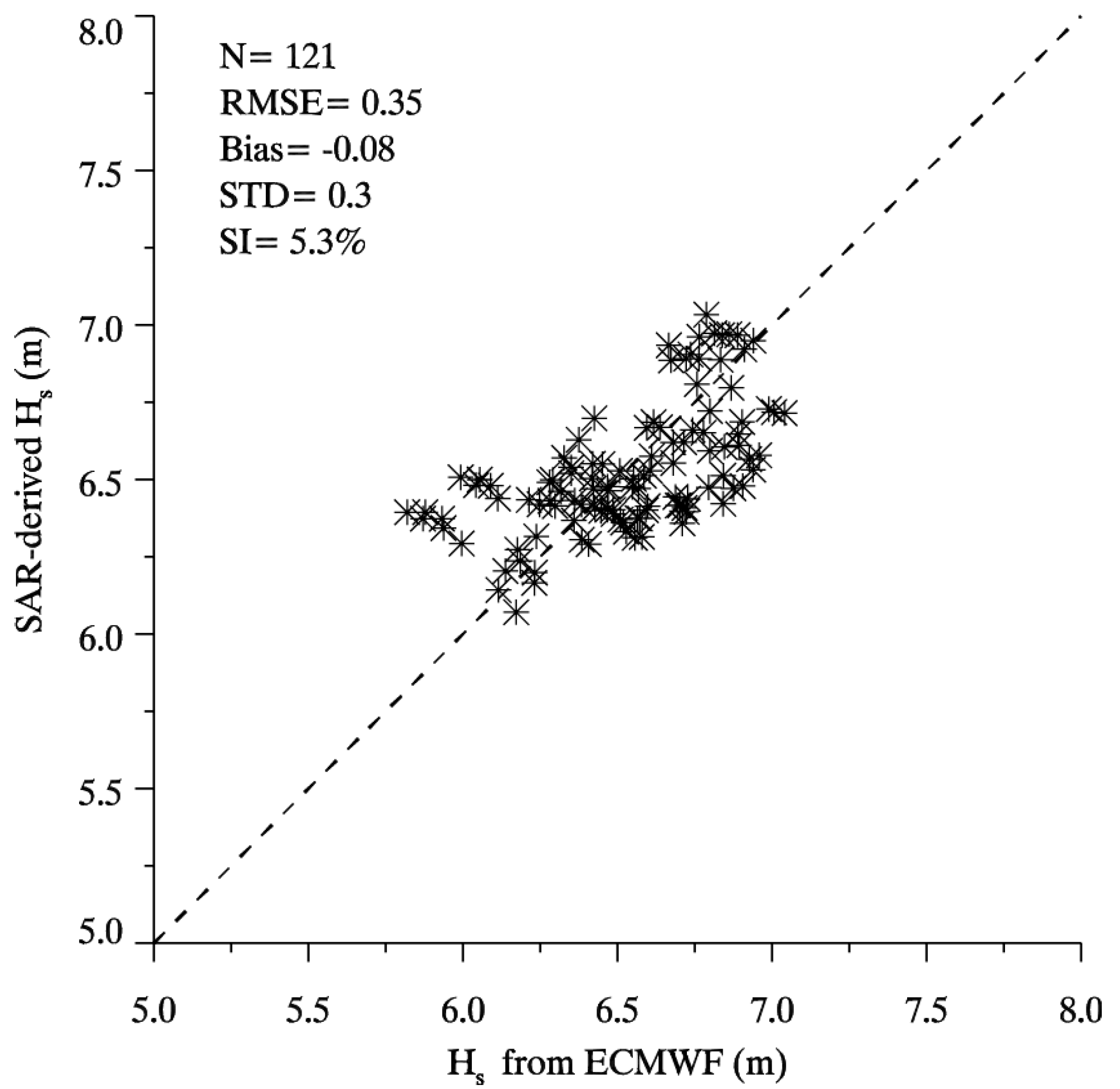
| C1 | 2.90 |
| C2 | 3.31 |
| C3 | 0.47 |
| C4 | 0.58 |
| C1 | 2.11 |
| C2 | 2.21 |
| C3 | 0.91 |
| C4 | 0.64 |
© 2017 by the authors. Licensee MDPI, Basel, Switzerland. This article is an open access article distributed under the terms and conditions of the Creative Commons Attribution (CC BY) license (http://creativecommons.org/licenses/by/4.0/).
Share and Cite
Shao, W.; Wang, J.; Li, X.; Sun, J. An Empirical Algorithm for Wave Retrieval from Co-Polarization X-Band SAR Imagery. Remote Sens. 2017, 9, 711. https://doi.org/10.3390/rs9070711
Shao W, Wang J, Li X, Sun J. An Empirical Algorithm for Wave Retrieval from Co-Polarization X-Band SAR Imagery. Remote Sensing. 2017; 9(7):711. https://doi.org/10.3390/rs9070711
Chicago/Turabian StyleShao, Weizeng, Jing Wang, Xiaofeng Li, and Jian Sun. 2017. "An Empirical Algorithm for Wave Retrieval from Co-Polarization X-Band SAR Imagery" Remote Sensing 9, no. 7: 711. https://doi.org/10.3390/rs9070711





